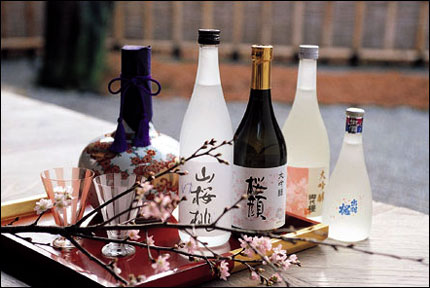CIDER:
Cider is made from fruit juice and sugar, and can exist in two forms; alcoholic and non-alcoholic. The alcoholic version is also referred to as “hard cider”. Cider often looks very similar to beer. The main difference between the two beverages is in the amount of sugar used – sugar being significantly higher in quantity in ciders.
HARD LIQUOR:
While the basic ingredients of beer and hard liquor may seen similar (water, yeast, sugar), beer is a product of a set of alcohol content whereas hard liquor is a concentrated produce whose alcohol content can vary depending on whether it is mixed with other beverages. The amount of “pure alcohol” in these drinks also vary quite a bit, from the diagram below, you will see that beer contains only about 5% of “pure alcohol” compared to 40% in Brandy, a form of hard liquor.
This alcoholic drink is made from rice. Fermented rice starch is converted into sugars. The process is similar to the production of beer, the main difference being that beer production employs a mashing process (Mashing is a step in the brewing process that combines crushed Malts with hot water in a mash tun to convert complex starches into simple sugars that are more readily fermented) to convert starch to sugars, whereas rice wine uses the amylolytic process (Amylolytic process or amylolysis is the conversion of starch into sugar by the action of acids or enzymes such as amylase).
Rice wine typically has a higher alcohol content, 18%–25% ABV, than grape wine (9%–16%), which in turn has a higher alcohol content than beer (usually 4%–6%).
WINE:
Wine is an alcoholic beverage made from fermented grapes or other fruits. The natural chemical balance of grapes lets them ferment without the addition of sugars, acids, enzymes, water, or other nutrients.
Of all the types of alcohol, wine is most well known for its health benefits. However, consume wine over your natural consumption abilities and the immediate undesirable effect of alcohol will kick in too.
Alternatives?
Look out for beverages with little to no alcoholic content. These days, non-alcoholic beer is increasingly popular and available in good brewery-pubs. Since all alcoholic beverages are made from natural ingredients, consumption in little to moderate amounts is still acceptable for the body.


 St Patrick’s Day – renown
for its shamrock, stout and green beer. But did you know that that the beer on
St Patrick’s day is green because colouring is added to the beer? That’s right,
it’s not because of a natural ingredient that they use during the production
process!
St Patrick’s Day – renown
for its shamrock, stout and green beer. But did you know that that the beer on
St Patrick’s day is green because colouring is added to the beer? That’s right,
it’s not because of a natural ingredient that they use during the production
process!
